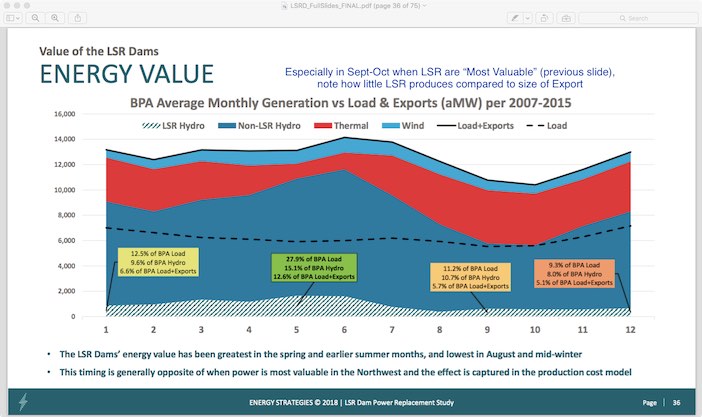forum
library
tutorial
contact

Another Crack in the
Snake River Dams
by Giulia C.S. Good Stefani
NRDC Blog, April 4, 2018
|
the film forum library tutorial contact |

|
Another Crack in the
by Giulia C.S. Good Stefani
|
 The single best thing we could do to save our region's endangered salmon and the last 76 Southern Resident killer whales is to retire the four lower Snake River dams. The pressure is mounting on those dams to come down.
The single best thing we could do to save our region's endangered salmon and the last 76 Southern Resident killer whales is to retire the four lower Snake River dams. The pressure is mounting on those dams to come down.
We can replace the four lower Snake River dams' power with clean resources that provide superior system reliability--easily meeting peak and off-peak loads at low cost, while keeping greenhouse gas emissions at current (or lower) levels, a new study released today by the NW Energy Coalition found. If we consider the substantial long-term cost of maintaining the aging dams (estimated in a 2015 study at $269 million/year), it could very well be cheaper to retire the dams than to keep them.
In the 1960s and early 1970s, the federal government built four large dams on the Snake River in eastern Washington State: Ice Harbor, Lower Monumental, Little Goose, and Lower Granite. For the Snake River--once estimated to produce almost half of the mighty Columbia Basin's salmon--things were never the same. Today, only about 1 percent of Snake River salmon make it home to spawn.
Salmon are the backbone of the pacific northwest, and without them, well, I don't dare imagine a Pacific Northwest without them. We are salmon people. The dramatic downward spiral toward extinction of salmon across the west, but especially in the Columbia Basin, has devastated communities, robbed Tribes of their ancestral and treaty rights, and starved the Southern Resident killer whales.
I'm a lawyer, mostly for whales, not an energy expert. For years, I've heard the agencies say that we need these four dams to “keep the system reliable” and to “meet peak power loads.” You can find those messages today on the Army Corps of Engineers website. This study outlines a feasible way to replace the dams and improve overall system reliability, resource adequacy, and ability to meet peak load requirements. It points the way to a better future for both power generation and the return of salmon.
This is good news because it isn't any old back of the envelope finding. The study took months to run by a well-regarded firm that regularly works in the utility industry. That firm used data from Bonneville Power Administration and models accepted by federal agencies and the utilities. It relied on highly conservative estimates of the future costs of renewables.
It's also good news because the agencies have been ordered by a federal judge to find a way to manage the Columbia and Snake River dams that doesn't jeopardize the continued existence of salmon. This same judge has ordered federal defendants very directly to take a hard look at lower Snake River dam removal.
It's hard to admit when you've been wrong about something. The federal agencies have invested 12-15 billion dollars in salmon restoration efforts in the Columbia and Snake Basin that hasn't brought a single listed salmon run back from the brink. They have spent nearly three decades fighting in court to hold onto these dams. Five federal plans have been declared illegal by three federal judges.
The killer whales and the salmon have all the answer I need--they tell me the current system isn't working. Something big has to change. We know dam removal restores rivers and it brings fish back--faster and more successfully than even the scientists anticipated.
I'm not the only one who has heard the whales and salmon call for help. Citizens of the region are eager to make changes to their rivers for the better. A recent poll found that 74 percent of Washington residents would pay up to $1 a month to save salmon. And 64 percent would pay up to $7 a month.
Even without factoring in the significant capital costs savings that will be needed to keep the 40-50 year old dams in service over time, the study says that for pennies a day, or about $1 a month for the average ratepayer, we can jump start the largest river restoration in U.S. history. We can return 140 miles of free-flowing main stem Snake River and open the gates to more than 5,000 river and stream miles in the most pristine, contiguous, high-elevation salmon habitat remaining in the lower 48.
The salmon, killer whales, all of us are ready.
learn more on topics covered in the film
see the video
read the script
learn the songs
discussion forum
